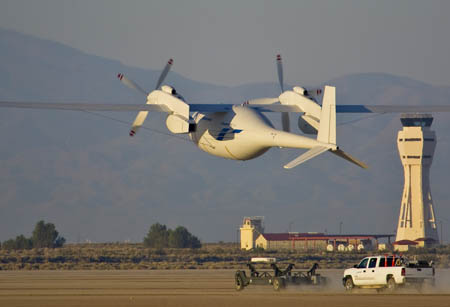Boeing’s  Phantom Eye remotely piloted aircraft completed its first autonomous flight, announced the company June 4. The liquid-hydrogen-powered airplane reached an altitude of more than 4,000 feet and a cruising speed of 62 knots during its 28-minute flight on June 1 at Edwards AFB, Calif., states the company’s release. Despite the aircraft suffering damage to its landing gear after touchdown in a dry lakebed, Boeing Phantom Works President Darryl Davis said the flight “ushers in a new era of persistent intelligence, surveillance, and reconnaissance where an unmanned aircraft will remain on station for days at a time, providing critical information and services.” He added, “This flight puts Boeing on a path to accomplish another aerospace first—the capability of four days of unrefueled, autonomous flight.” Phantom Eye underwent taxi tests in April in preparation for the inaugural flight. The demonstrator aircraft, with a 150-foot wingspan and 450-pound payload capacity, is designed to provide persistent monitoring over large areas from its cruising altitude of up to 65,000 feet.
Phantom Eye remotely piloted aircraft completed its first autonomous flight, announced the company June 4. The liquid-hydrogen-powered airplane reached an altitude of more than 4,000 feet and a cruising speed of 62 knots during its 28-minute flight on June 1 at Edwards AFB, Calif., states the company’s release. Despite the aircraft suffering damage to its landing gear after touchdown in a dry lakebed, Boeing Phantom Works President Darryl Davis said the flight “ushers in a new era of persistent intelligence, surveillance, and reconnaissance where an unmanned aircraft will remain on station for days at a time, providing critical information and services.” He added, “This flight puts Boeing on a path to accomplish another aerospace first—the capability of four days of unrefueled, autonomous flight.” Phantom Eye underwent taxi tests in April in preparation for the inaugural flight. The demonstrator aircraft, with a 150-foot wingspan and 450-pound payload capacity, is designed to provide persistent monitoring over large areas from its cruising altitude of up to 65,000 feet.
While the Space Force is still making long-term plans to establish high-fidelity live and virtual test and training ranges in the coming years, officials say they're also working with operators to identify near-term gaps and quickly field capabilities to address them.

